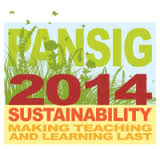Everyone is weird
Some are weirder than others
This article (thanks Ryan) made a lot of sense to me. It’s basically talking about how incredibly successful self-taught people (like Mr. Gates, who is currently trying to remake education in his own image) may have a view of the world that is skewed towards their own experiences and abilities.
I often find something similar in my teaching. I love reading and don’t enjoy deliberate study, so I often encourage my students to do the same. Invariably some of them don’t enjoy reading and do enjoy studying, and a few enjoy neither of those activities.
I think it’s important for teachers to keep this in mind: we are not the same as our students, and their preferences are likely not the same as ours either. It’s easy to forget, but something I keep coming back to.
Pan-SIG 2014
I just got back from this year’s JALT Pan-SIG Conference in Miyazaki. The Pan-SIG is my favourite conference, and it’s one I try not to miss every year. I think this was my fifth or sixth Pan-SIG.
I love the Pan-SIG because it’s run by the SIGs, and everyone is really into what they are doing. It’s more concentrated than the JALT National Conference, and the overall quality of presentations tends to be higher. The smaller size also makes it a great place to meet and talk to people.
This year’s venue was fantastic. I had never been to Miyazaki before, but was really impressed. A friend said “it feels more like Miami than Japan” and I agree: wide streets, palm trees, low buildings, lots of space, and not at all crowded. The university where the conference was held was downtown, easily accessible, and very comfortable.
Unfortunately I was only able to attend the first day as Miyazaki isn’t the easiest place to get to from Sendai 🙂
The 2014 Pan-SIG tried a couple of new things, and I’ll talk about each one below:
1. Information/sustainability
The organizers didn’t produce any printed material for the conference, instead publishing the program online. I completely support this approach and agree that most conferences are very wasteful in terms of printing a bunch of stuff that no-one ends up keeping or reading afterwards.
However, this time round there were a few gaps that should be addressed in the future (or at other conferences). The online information didn’t seem to be complete or at least wasn’t intuitive enough for me to find. I actually didn’t know about some of the rooms so missed half the poster sessions.
I think even if the conference goes paperless a simple one-page handout with a map and a list of presentations is necessary. It’s also necessary to have signs indicating where things are, and to make sure that the student volunteer staff know the rough schedule and where things are (I asked half a dozen people where the poster sessions were, but none of them understood what I was talking about).
2. Replacing presentations with poster sessions
I am not a fan of this. I think posters and presentations are very different beasts, and much prefer to give or attend presentations. Posters work well if they can be displayed in the lunch room or the publisher area and are a great way to get ideas or see what people are doing.
However, I think we lost something this year by not having presentations. Presentations require more preparation, and tend to provide a deeper understanding of a topic. I hope we’ll see a more balanced approach in the future. I think the model of hanging posters in the morning and leaving them up all day, along with a long lunch break with access to the poster presenters, works well. Simultaneous presentation sessions can then be run before and after.
Overall
On the whole, I enjoyed the conference. The first plenary talk about reconstruction in Tohoku was incredible: interesting, accessible, and illuminating. I talked to a lot of friends and met some new ones. The whole thing, with the exception of the information issues above, was extremely smooth and well run.
I’m not sure where the next Pan-SIG will be held, but I’m already looking forward to it.
REVIEW: The Book Whisperer – Donalyn Miller
How to teach reading
I just got round to reading The Book Whisperer, which is a bit late, especially as the author was here in Japan for the 6th ER Seminar last year.
Unfortunately I wasn’t able to make it to the Seminar, but I was aware of the book from there.
The reason I ended up reading it this week is because I visited SEG last weekend, and the book came up in conversation with Akio Furukawa. On the train back to Sendai I downloaded the Kindle version and read it in spurts and starts this week.
The one-sentence summary: it describes how teachers can help learners discover the joy of reading through a combination of free reading and counselling. It’s very similar to what the teachers at SEG do, which is what led to us talking about it and me reading it.
I enjoyed the book very much. I think it will appeal to teachers who like reading, teachers that believe in guiding students rather than teaching them, and teachers that believe in learner autonomy.
Miller writes from a US language arts perspective, but similar principles can apply to ESL and EFL contexts. The book is light and easy to read, with lots of examples taken from her students and other teachers. If anything, Miller relies a bit too much on Kraschen for academic support, but it doesn’t really detract from her message.
Highly recommended. 9/10
How do you help your students with reading?
The New School Year
The school year starts in April in Japan, and my university classes start next week.
In the first semester I’ll be continuing with the extensive reading classes according to the ER@TU system, as well as trialing the latest version of Dan E’s discussion curriculum. We’re hoping to write a discussion manual later in the year, similar to the extensive reading one. I think the content for this next manual will be even more ground-breaking and useful for teachers.
My focus for the first semester will be to get to know my students better and provide them with more personalized support. Right now I feel my systems are good, so the classes are decent, but the next step is to try to make personal connections with students.
With over 400 students this won’t be easy, but I think it’s worth trying.
What is your goal for the new school year?
curriculum eikaiwa expectations language courses school management university
by sendaiben
2 comments
Kaizen, the art of gradual improvement
An essential part of program development
I mentioned kaizen (continuous improvement) at the end of my talk on ER program design.
Kaizen is making things better, continuously. Basically finding and solving problems over and over again. Over time, this results in huge improvements and the evolution of programs.
I’ve been very fortunate to be able to work with my colleague Dan E at Tohoku University, who is a master of kaizen. Thanks to this, our extensive reading program is several orders of magnitude better than it was when we started collaborating.
At Cambridge English as well, thinking back to when we started over ten years ago the school and the classes are unrecognizable. Almost everything we do, we do better now.
But kaizen does not happen automatically. It requires teachers to have the desire and the ability to make changes. It also requires a culture of development, where problems lead to solutions that are implemented across the board. Communication is essential and talking about problems with colleagues leads to better solutions.
Some examples of kaizen at Tohoku University:
- improving worksheets so that students understand them better
- developing bilingual explanations
- sharing effective class activities
- developing protocols to deal with cheating
- having students write book reports in class instead of for homework
Examples of kaizen at Cambridge English:
- developing electronic and paper record keeping
- writing student names in romaji on everything (books, notebooks, attendance cards)
- developing lesson plans
- choosing materials
- organizing the classroom
As you can see, nothing groundbreaking. The main point is that improvements are continuous, problems are dealt with as they come up, solutions are reached through communicating with colleagues and are implemented by everyone.
Kaizen is barely noticeable in the short term, but over a longer period the improvements are staggering.
Do you have any positive or negative experiences with kaizen?




